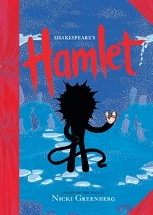Hamlet by Nicki Greenberg

Allen and Unwin 2010. ISBN 978 1 74175 8425.
Graphic Novel. Any reimagining of Shakespeare's Hamlet is sure
to
create opinions that are poles apart, and this one certainly will,
having Hamlet portrayed as an ink blot, weaving his way through the
morass of pressures that he has on his young life. Sometimes the plot
is outlined as a graphic novel, in comic strip style, sometimes a full
page takes up the story, but all is easily read and followed. Having a
copy in the classroom where Hamlet is being studied will give
inveterate students a different perspective on this most known of
plays, while copies in the library will serve others well as they
peruse the pages for images not usually seen on the black and white
texts we are used to.
Imagined as a theatre on which these ephemeral actors 'strut upon the
stage', the inkblots score a visual joke from the artist, all in black,
of course, dropping like a blot upon the page but now adorned with
faces, and in the end, return once more as blots to be removed with
blotting paper. Sometimes the ink blot of Hamlet removes his face, a
mask, not wanting to see what is happening around him, sometimes his
face is happy, belying what is going on underneath. Other characters
are imagined in different ways, Ophelia is a monkey faced creature with
a voluptuous Mae West figure, dancing to the tune of her father;
Polonius, a walking dead man, with a skeletal face and whiskers
about his jaw line, using a cane to walk; the king and queen are
seahorses; Hamlet's friends, Rosencratz and Gilderstern are a single
being with two heads and so on, all making the reader think about why
Greenberg has used such tantalizing images to portray the known
characters.
Hamlet's sword, a fountain pen, sways around the place, emphasizing his
impatience with his lot: 'oh cursed spite that ever I was born to make
it right'. The pages all are heavily black, underscoring the deep
tragedy of Hamlet's role as the agent for revenge for his dead father,
while the stage actors who play a pivotal role in exposing the king's
guilt, are in red. I love the clock innards used often on the pages,
underscoring the time element in the play, 'the time is out of joint'
but could as easily represent Hamlet's inner thoughts as he meets his
fate. There is a myriad of images, of subtle puns, of visual jokes to
be gained from this reimagining, and discussions with classes will
further endear the play to the next generation of students who are
endowed with a greater visual awareness.
Fran Knight